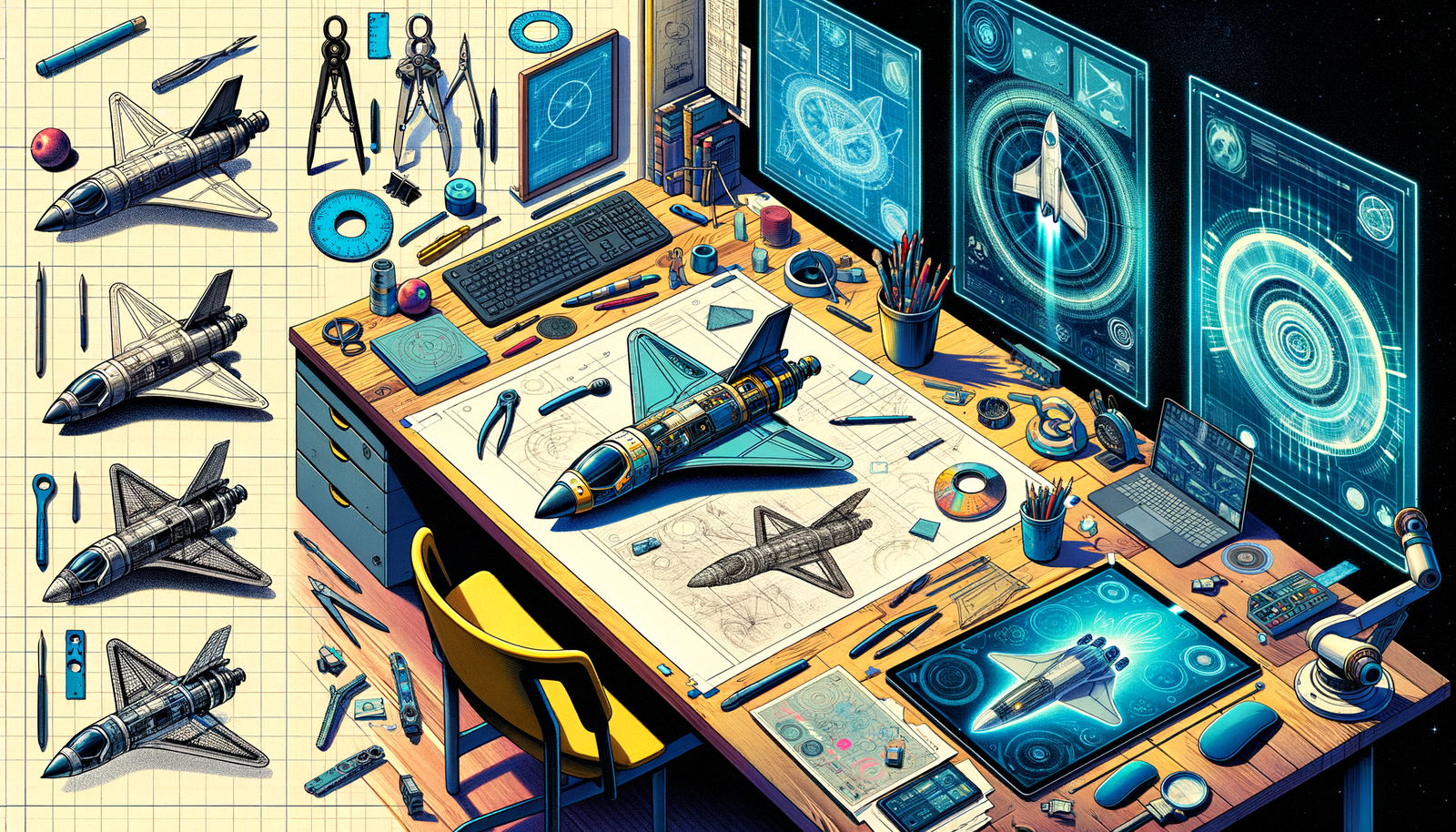Your Cart is Empty
Early Beginnings and Pioneering Innovations
Pre-digital Age
In the early days of aerospace engineering, before the digital revolution, the design process was a labor-intensive and time-consuming endeavor. Engineers relied heavily on manual drafting techniques and physical modeling to bring their concepts to life. Large drafting tables, pencils, compasses, and other manual tools were the mainstays of the design process. Physical models, often meticulously crafted by hand, played a crucial role in visualizing and testing concepts.
These early methods presented numerous challenges. The complexity of aerospace structures demanded high precision, and even minor errors could lead to significant issues later in the process. Moreover, manual drafting was inherently limited by human error and the time required to produce detailed drawings. The need for a more efficient, accurate, and versatile approach was evident.
Introduction of Computer-Aided Design (CAD)
The introduction of Computer-Aided Design (CAD) marked a transformative moment in aerospace engineering. One of the earliest and most significant developments in CAD technology was Ivan Sutherland’s Sketchpad, introduced in the early 1960s. Often referred to as the precursor to modern CAD, Sketchpad introduced the concept of graphical user interfaces and allowed engineers to interact with their designs more intuitively using a light pen to draw directly on a screen. This innovation laid the groundwork for the development of more advanced CAD systems.
Another key figure in the evolution of CAD was John Walker, who founded Autodesk in 1982. Walker and his team developed AutoCAD, a program that democratized access to CAD tools by making them available on personal computers. AutoCAD revolutionized the design process by providing engineers with powerful drafting and design capabilities, significantly reducing the time and effort required to create complex drawings.
Rise of Specialized Aerospace Design Software
The Advent of CATIA
As the aerospace industry grew, so did the need for specialized design software tailored to its unique requirements. One of the most influential developments in this regard was the creation of CATIA (Computer Aided Three-dimensional Interactive Application) by Dassault Systèmes in the late 1970s. Initially developed for designing fighter jets for the French military, CATIA quickly gained prominence in the aerospace sector.
CATIA’s impact on aerospace giants like Boeing and Airbus was profound. It provided comprehensive tools for 3D modeling, surface design, and assembly management, enabling these companies to design more complex and efficient aircraft. Boeing, for instance, used CATIA extensively in the development of the Boeing 777, which became the first commercial aircraft to be designed entirely using 3D CAD software.
Development of Solid Modeling
The introduction of solid modeling techniques further revolutionized aerospace design. Unlike traditional wireframe and surface modeling, solid modeling allowed engineers to create highly detailed and accurate representations of physical objects. This capability was crucial for aerospace applications, where precision and reliability are paramount.
One of the key contributors to the development of solid modeling was Dr. Patrick Hanratty, often referred to as the “father of CAD/CAM.” Hanratty’s work led to the creation of ADAM (Automated Drafting and Machining), which laid the foundation for modern solid modeling techniques. His innovations enabled engineers to perform complex simulations and analyses on their designs, leading to more robust and reliable aerospace structures.
Integration of Advanced Simulation and Analysis Tools
Finite Element Analysis (FEA)
As design software evolved, so did the need for advanced simulation and analysis tools. One of the most significant advancements in this area was the incorporation of Finite Element Analysis (FEA) into design software. FEA allowed engineers to perform detailed structural analysis by breaking down complex structures into smaller, manageable elements. This technique provided crucial insights into the behavior of materials and structures under various conditions.
Companies like Ansys and Abaqus were pioneers in this field, developing sophisticated FEA tools that became indispensable in aerospace engineering. Ansys, founded by Dr. John Swanson in 1970, developed software that enabled engineers to simulate and analyze the structural integrity of aircraft components. Abaqus, initially developed by Hibbitt, Karlsson & Sorensen, offered powerful FEA capabilities that were widely adopted in the aerospace industry.
Computational Fluid Dynamics (CFD)
Another critical advancement was the evolution of Computational Fluid Dynamics (CFD) tools. CFD allowed engineers to simulate and analyze the behavior of fluids (air, in the case of aerospace) around complex geometries. This capability was particularly important for optimizing aerodynamic performance and reducing drag.
Major players in the CFD arena included Fluent, now part of Ansys, and Altair’s HyperWorks. Fluent, founded in 1988, developed advanced CFD software that became a standard tool in aerodynamic analysis. Altair’s HyperWorks suite included powerful CFD tools that enabled engineers to simulate and optimize fluid flow around aircraft structures, leading to more efficient and aerodynamic designs.
Modern Innovations and Future Directions
Artificial Intelligence and Machine Learning
In recent years, the integration of Artificial Intelligence (AI) and Machine Learning (ML) has opened new frontiers in aerospace design. AI-driven design optimization and predictive maintenance are transforming the industry by allowing engineers to create more efficient and reliable designs. These technologies use vast amounts of data to identify patterns and make informed decisions, leading to significant improvements in performance and safety.
Companies like Siemens NX and Autodesk Fusion 360 are at the forefront of this innovation. Siemens NX, for example, incorporates AI and ML algorithms to optimize design processes and predict potential maintenance issues before they occur. Autodesk Fusion 360 leverages AI to provide real-time design recommendations and automate repetitive tasks, enhancing the efficiency and effectiveness of the design process.
Additive Manufacturing (3D Printing)
The advent of Additive Manufacturing, commonly known as 3D printing, has revolutionized aerospace design by enabling the creation of complex geometries that were previously impossible to manufacture. Design software plays a crucial role in this process by allowing engineers to create detailed digital models that can be directly translated into 3D printed components.
Companies like Stratasys and GE Additive have been pioneers in this field. Stratasys, founded in 1989, developed some of the earliest 3D printing technologies and continues to innovate with advanced materials and techniques. GE Additive, a subsidiary of General Electric, has made significant strides in using 3D printing for aerospace applications, including the production of critical engine components.
Virtual and Augmented Reality
The integration of Virtual Reality (VR) and Augmented Reality (AR) into aerospace design software has opened new possibilities for visualization and simulation. These technologies provide immersive experiences that allow engineers to interact with their designs in entirely new ways, enhancing their understanding and ability to identify potential issues early in the process.
Pioneering efforts by companies like Unity and PTC’s Vuforia have driven the adoption of VR and AR in aerospace engineering. Unity’s development platform enables the creation of immersive VR experiences, while PTC’s Vuforia offers powerful AR capabilities that can overlay digital information onto physical objects. These tools are transforming the way engineers visualize, simulate, and interact with their designs, leading to more innovative and efficient aerospace solutions.







